#quing dynasty
Photo

The Peach Festival of the Queen Mother of the West, Ming or Qing Dynasty, 17th-18th century by Chinese School (ink and colour on silk)
#asian art#asian#art#artwork#chinese#chinese school#chinese art#china#ming dynasty#quing dynasty#peach festival#peach#festival#chinese festival#asian festival#ink#silk#seide#lanscape#asian landscape#chinese landscape#temple#temples#taosim#culture#asian culture
17 notes
·
View notes
Photo
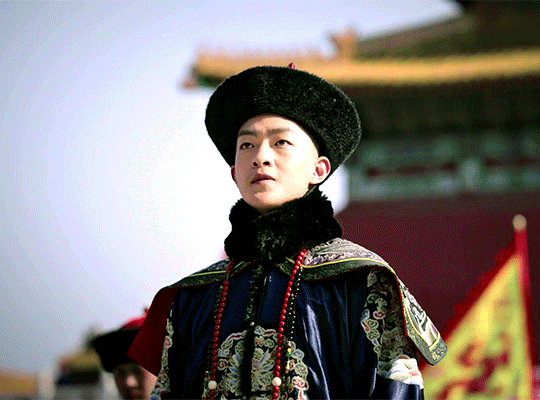

Legend of Ruyi | Yongqi, Prince Rong
#legend of ruyi#如懿传#cdrama#perioddramaedit#cdramanet#cdramaedit#cdramagifs#gzh#ruyi zhuan#qing dynasty#屈楚乔#qu chuxiao#ruyicostumes#wardrobe#asiandramanet#perioddramasource#onlyperioddramas#chinese drama
98 notes
·
View notes
Text


i found this on the floor of me dinner boat should i ave a wank and a taste???
#biscuitville#the shoemakers elf#elsa#princess elsa#elsa the snow queer#elsa the ice queen#quing#qing dynasty#xhongli
0 notes
Text
Some Chinese fashion styles
Disclaimer: The following styles and their definitions were observed by me and are not authoritative. I am only familiar with Hanfu and if I made mistakes and picked the wrong photo examples or fraud shops, please let me know. Also, this post focused on women's fashion because 1. I am not into men's fashion so I don't know much about them. 2. The algorithm also knew that so I don't really see them.
汉服/Hànfú
传统服饰/Chuántǒng fúshì (传服/chuán fú)
清汉女/Qīng hàn nǚ
旗装/Qí zhuāng
旗袍/Qípáo
新国风/Xīn guó fēng、新中式/Xīn zhōngshì
汉元素/hàn yuánsù
茶艺服/Cháyì fú or 茶服/chá fú
唐装/Tángzhuāng
中山装/Zhōngshānzhuāng.
汉服/Hànfú
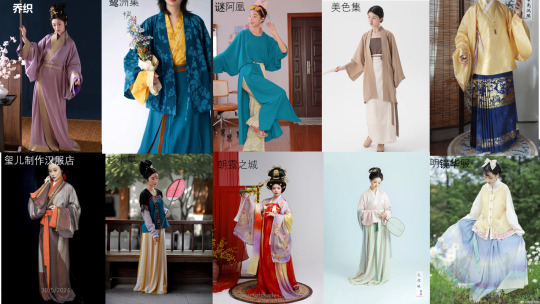
The ethnic clothing of Han Chinese (not the Han Dynasty).
There was a prohibition of Han clothing and hair styles in Qing dynasty, i.e. the 剃发易服/Tìfā y��fú qu Queue Ordinance, so modern hanfu is an on-going revivalist moment.
Modern hanfu are based on archeological evidences with minor twists to suit modern like, such as the type of fabric used and cut.
As a result, there are many types of garments and sub-styles. The figure above shows some examples.
While which style should be included and promoted is a constant debate, but in general, the cutout line is the Qing dynasty (however small accessories such as purses are alright).
传统服饰/Chuántǒng fúshì (传服/chuán fú)
No example because I am not sure who identified with this label.
The Chinese traditional clothing.
This either referred to historical clothing restorers (regardless of ethnicity) or people who promoted that the traditional clothing of Han people should be in the late Ming dynasty style, since "people should get up at where they had fallen".
They might be agreeable with the hanfu movement or not.
清汉女/Qīng hàn nǚ
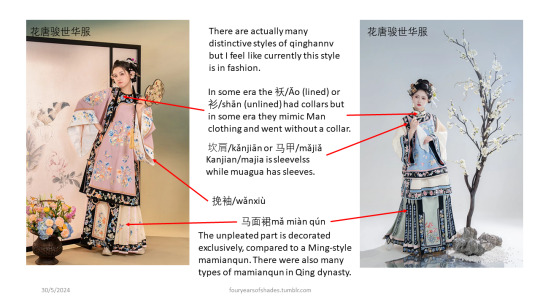
The clothing of women of Han Chinese in the Qing dynasty.
Since the Queue Ordinance wasn't that strictly enforced on Han women, the Han women clothing in the Qing dynasty had quickly absorbed Manchurian's elements while retaining the characteristic two-piece silhouette. (Manchurian women wore a one-piece robe.)
I believed it appeared around 2019 when the styles of hanfu had moved to fully embroidered surface to a more tone down brocade or weaved patterns.
旗装/Qí zhuāng

The ethnic clothing of Man people (Manchurian).
The women's clothing are generally in round collar opened on the left (youren) with straight sleeves.
The most basic item is a 衬衣/chènyī, which doesn't have vents.
However, the most common item I have seen on the street is a 氅衣/chǎng yī (probably rented), which should be worn on top of 衬衣, since they have side vents.
They usually have no standing-up collar but in some cases a fake collar could be worn.
On top of changyi they could wear a 马褂/mǎguà、坎肩/kǎnjiān、褂裥/guà jiǎn.
旗袍/Qípáo
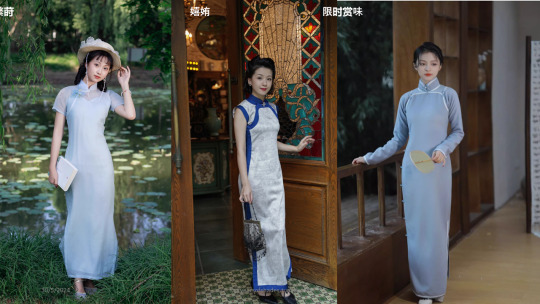
The Chinese clothing of women originated from the Minguo era, known in English as qipao or cheongsam.
The male equivalent is 长衫/chángshān.
Currently in style is the retro-cut, while uses the traditional flat cut (no shoulder seam) instead of the more body-hugging modern draping style.
There are also many variations and cuts, but the overall silhouette is similar.
新国风/Xīn guó fēng、新中式/xīn zhōngshì
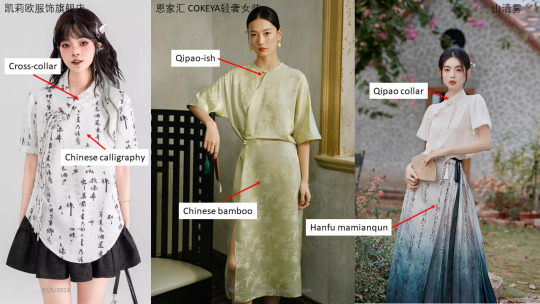
Innovative clothing that was inspired by Chinese traditional aesthetic.
It is an umbrella term.
汉元素/hàn yuánsù refers to clothing inspired by hanfu specifically, while xinguofeng could be inspired by qipao and other ethnic clothing. In addition, hanyuansu is a term more familair to hanfu-ers, so the target audience is slightly different between hanyuansu and xinguofeng.
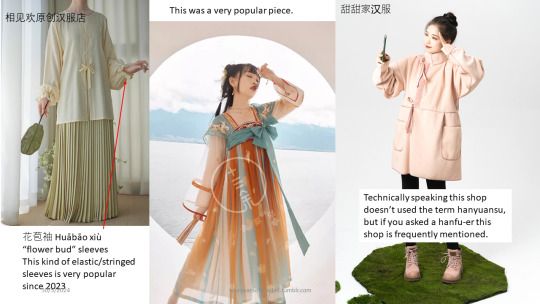
茶艺服/Cháyì fú or 茶服/chá fú,i.e tea dress, which aimed to convey a zen and rustic aesthetic could also be considered a sub-style. They are often worn by retirees, artists or workers in tea shops, calligraphy shops, Chinese spas, Chinese traditional medicine clinics etc.

The older "Chinese style" generally refers to 唐装/Tángzhuāng and 中山装/Zhōngshānzhuāng.
Tangzhuang (Tang Suit) was a men suit characterized with a mandarin collar with a row of 盘扣/pán kòu frogs in the middle. There are two pockets at the bottom front of the suit. It was a well-known looked worldwide due to the 2001 APEC summit. However, other clothes resembled a 马褂/mǎguà could also be called a tangzhuang.
Zhongshanzhuang was designed and named after Sun Yat-sen but was often known in English as the Mao Suit. Mao Suit was characterised with a 关门领/Guānmén lǐng(“closed-door collar", but also known as Mao collar in English) with a row of round buttons. There are four pockets at the front of the suit.
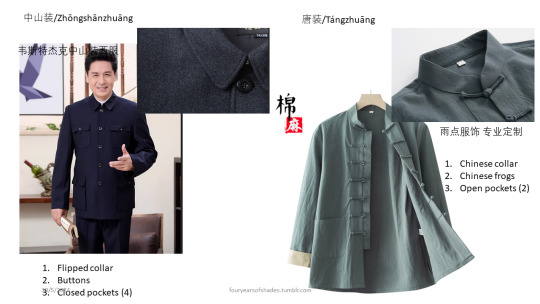
中华lolita/Zhōnghuá lolita
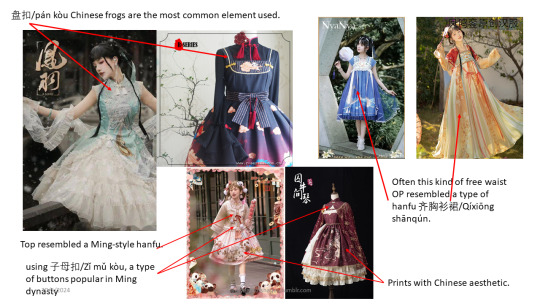
A sub-style of the lolita fashion inspired by cheongsam/qipao, hanfu or other Chinese artistic elements.
The same item could appeared in different styles, but with different cut and accessories. The following examples showed a mamianqun used in different styles.

THE END
#chinese fashion#hanfu#qinghannv#qipao#qizhuang#chinese language#non-hanfu#lolita fashion#terminology#i rarely seen men in alternate fashion#like i saw maybe one in the last year#they spent money elsewhere#like shoes#long post#reference#fouryearsofshades#i spent so much time on this post#hope you will like it#feel free to correct me if i am not right
535 notes
·
View notes
Text
[Hanfu · 漢服]Chinese Warring States period(475–221 BC) Traditional Clothing Hanfu-Life of Qu Yuan(屈原)
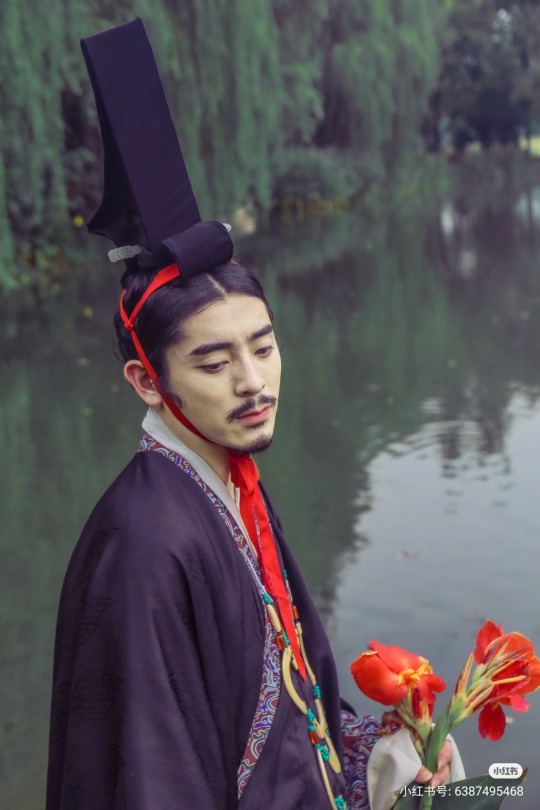
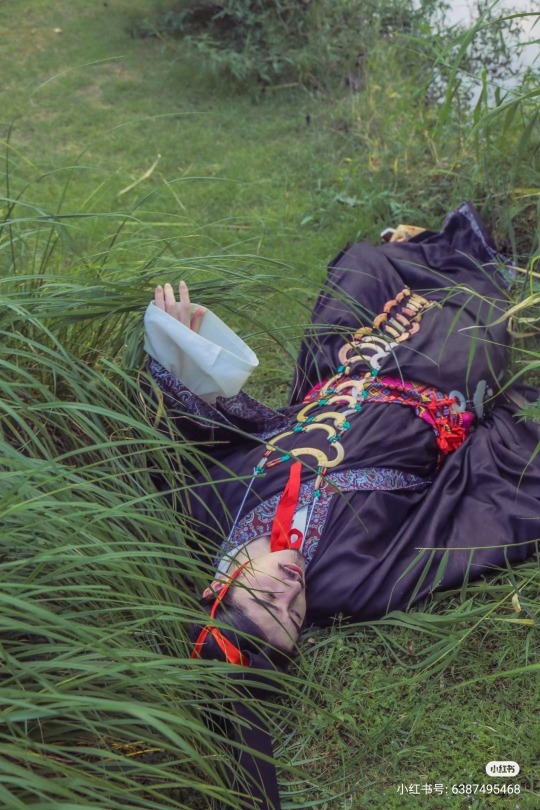
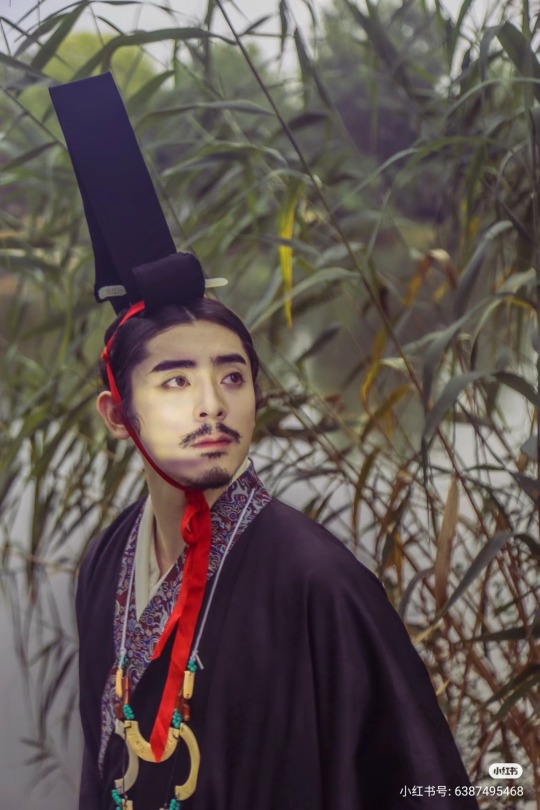

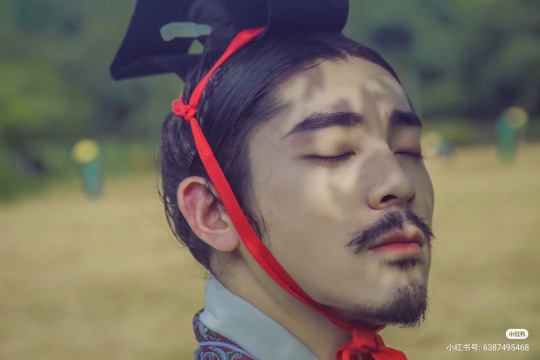
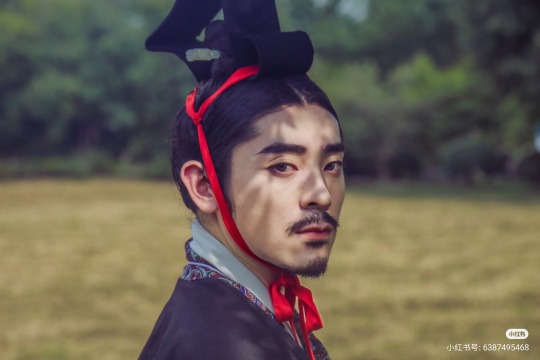
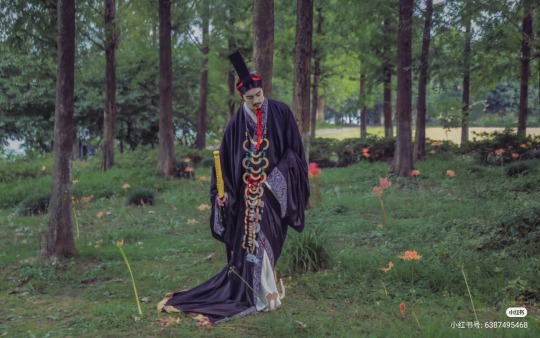
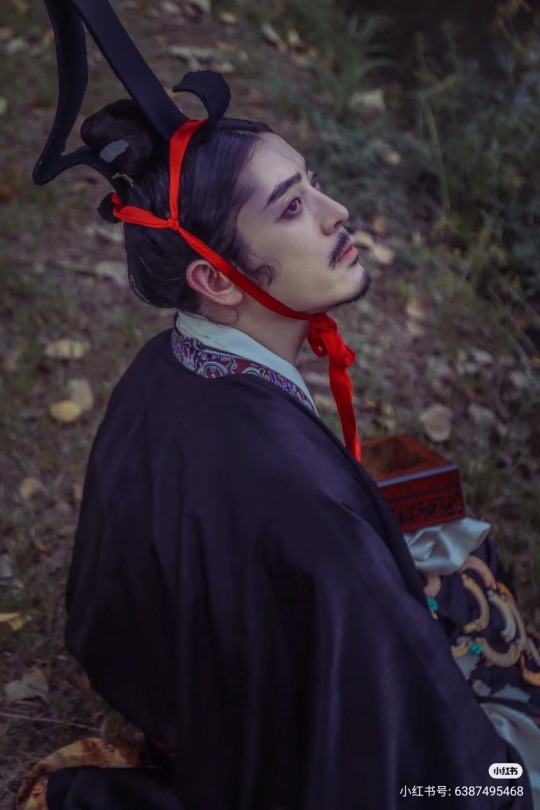
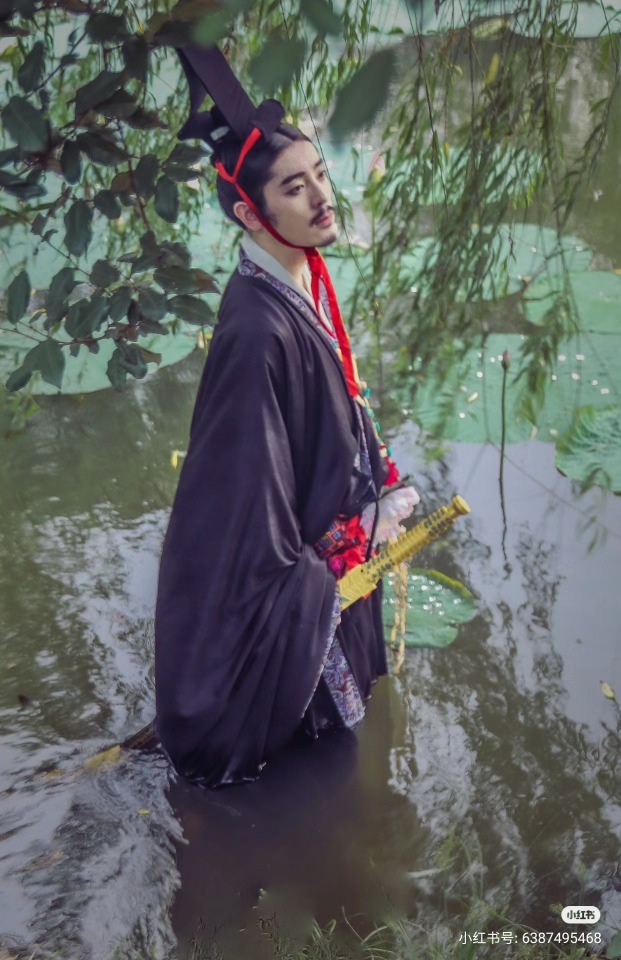
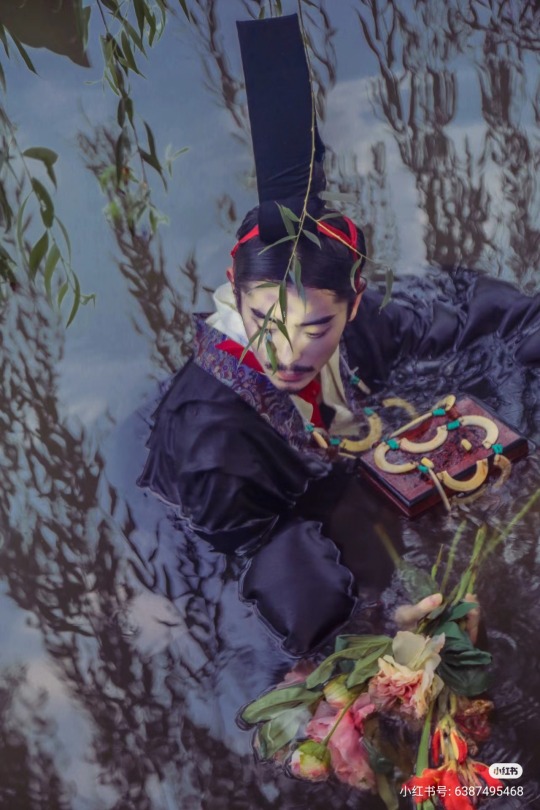
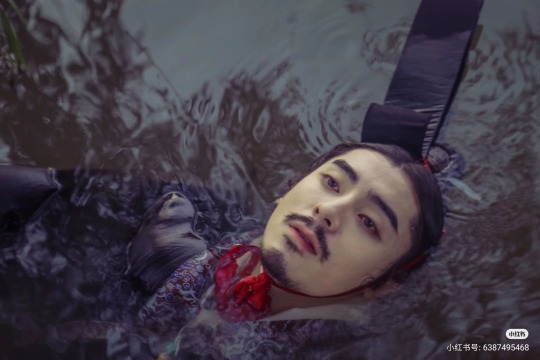
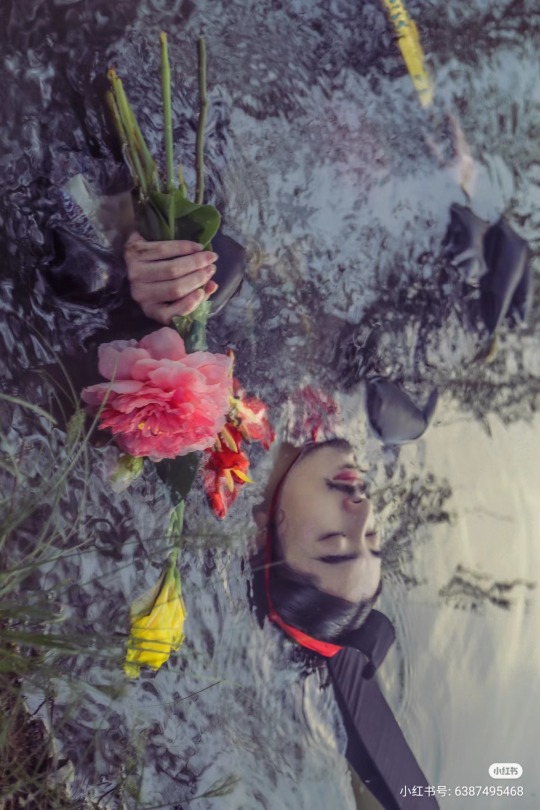

【Historical Artifact Reference】:
China Warring States period (475-221 BC):Silk painting depicting a man riding a dragon (人物御龍帛畫)
it was discovered in the Zidanku Tomb no. 1 in Changsha, Hunan Province in 1973. Now in the Hunan Museum
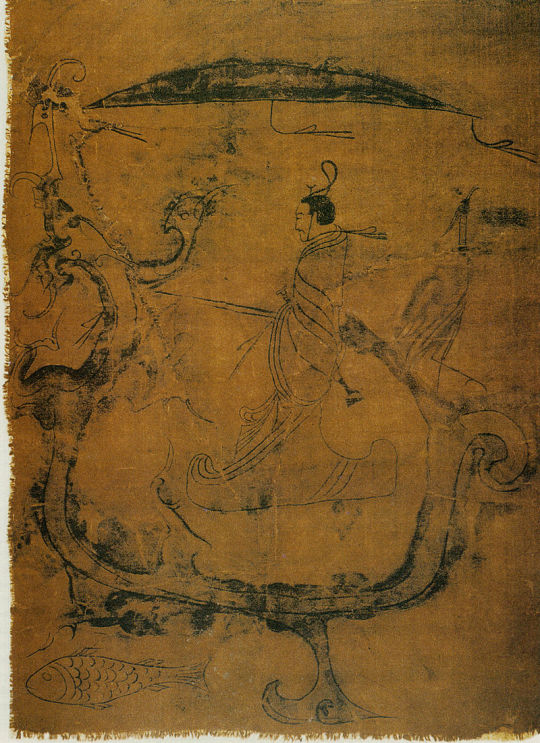
A man with a sword is riding a dragon by holding the rein. The dragon's body was given the shape of a boat. A little egret is standing at the tail of the dragon. A carp under the dragon is leading the way. The umbrella in the top middle of the picture shows the owner's nobility. The work has become associated with the Chu poet Qu Yuan’s famous verse from his poem Shejiang (涉江, Setting foot in the river), ‘Carrying a long sword with weird colour; Wearing a qieyun–styled high cap.” (帶長鋏之陸離兮, 冠切雲之崔嵬)
Western Zhou Dynasty seven-huang jade pendant with linked beads/西周七璜联珠组玉佩

About Qu Yuan(屈原)
Qu Yuan (c. 340 BC – 278 BC)was a Chinese poet and aristocrat in the State of Chu during the Warring States period. He is known for his patriotism and contributions to classical poetry and verses, especially through the poems of the Chu Ci anthology (also known as The Songs of the South or Songs of Chu): a volume of poems attributed to or considered to be inspired by his verse writing. Together with the Shi Jing, the Chu Ci is one of the two greatest collections of ancient Chinese verse. He is also remembered in connection to the supposed origin of the Dragon Boat Festival.
Historical details about Qu Yuan's life are few, and his authorship of many Chu Ci poems has been questioned at length.[4] However, he is widely accepted to have written "The Lament," a Chu Ci poem. The first known reference to Qu Yuan appears in a poem written in 174 BC by Jia Yi, an official from Luoyang who was slandered by jealous officials and banished to Changsha by Emperor Wen of Han. While traveling, he wrote a poem describing the similar fate of a previous "Qu Yuan."Eighty years later, the first known biography of Qu Yuan's life appeared in Han dynasty historian Sima Qian's Records of the Grand Historian, though it contains a number of contradictory details.
Life of Qu Yuan(屈原)
The only surviving source of information on Qu Yuan's life is Sima Qian's biography of him in Records of the Grand Historian (Shiji), although the biography is circumstantial and probably influenced greatly by Sima's own identification with Qu.Sima wrote that Qu was a member of the Chu royal clan and served as an official under King Huai of Chu (reigned 328–299 BC).
During the early days of King Huai's reign, Qu Yuan was serving the State of Chu as its Left Minister. However, King Huai exiled Qu Yuan to the region north of the Han River, because corrupt ministers slandered him and influenced the king.Eventually, Qu Yuan was reinstated and sent on a diplomatic mission to the State of Qi. He tried to resume relations between Chu and Qi, which King Huai had broken under the false pretense of King Hui of Qin to cede territory near Shangyu.
During King Qingxiang's reign, Prime Minister Zilan slandered Qu Yuan.[9] This caused Qu Yuan's exile to the regions south of the Yangtze River. It is said that Qu Yuan returned first to his home town. In his exile, he spent much of this time collecting legends and rearranging folk odes while traveling the countryside. Furthermore, he wrote some of the greatest poetry in Chinese literature and expressed deep concerns about his state. According to legend, his anxiety brought him to an increasingly troubled state of health. During his depression, he would often take walks near a certain well to look upon his thin and gaunt reflection in the water. This well became known as the "Face Reflection Well." On a hillside in Xiangluping (at present-day Zigui County, Hubei Province), there is a well that is considered to be the original well from the time of Qu Yuan.
In 278 BC, learning of the capture of his country's capital, Ying, by General Bai Qi of the state of Qin, Qu Yuan is said to have collected folktales and written the lengthy poem of lamentation called "Lament for Ying". Eventually, he committed suicide by wading into the Miluo River in today's Hunan Province while holding a rock. The reason why he took his life remained controversial and was argued by Chinese scholars for centuries. Typical explanations including martyrdom for his deeply beloved but falling motherland, which was suggested by the philosopher Zhu Xi of the Song dynasty, or feeling extreme despair to the situation of the politics in Chu while his lifelong political dream would never be realized. But according to "Yu Fu," widely considered to be written by Qu himself or at least, a person who was very familiar with Qu, his suicide was an ultimate way to protect his innocence and life principles.[citation needed]
Qu Yuan is said to have expressed his love for the ruling monarch, King Huai of Chu, through several of this works, including "The Lament" and "Longing for Beauty".
Dragon Boat Festival/端午节
Popular legend has it that villagers carried their dumplings and boats to the middle of the river and desperately tried to save Qu Yuan after he immersed himself in the Miluo but were too late to do so. However, in order to keep fish and evil spirits away from his body, they beat drums and splashed the water with their paddles, and they also threw rice into the water both as a food offering to Qu Yuan's spirit and also to distract the fish away from his body. However, the legend continues, that late one night, the spirit of Qu Yuan appeared before his friends and told them that he died because he had taken himself under the river. Then, he asked his friends to wrap their rice into three-cornered silk packages to ward off the dragon.
These packages became a traditional food known as zongzi, although the lumps of rice are now wrapped in leaves instead of silk. The act of racing to search for his body in boats gradually became the cultural tradition of dragon boat racing, held on the anniversary of his death every year. Today, people still eat zongzi and participate in dragon boat races to commemorate Qu Yuan's sacrifice on the fifth day of the fifth month of the traditional lunisolar Chinese calendar.
--------
Recreation Work by : @晴南
Xiaohongshu🔗:http://xhslink.com/CU2x9J
--------
#chinese hanfu#Warring States period(475–221 BC)#Qu Yuan(屈原)#State of Chu#china history#chines history#hanfu#hanfu accessories#hanfu_challenge#chinese traditional clothing#china#chinese#chinese aesthetics#chinese historical fashio#漢服#汉服#中華風#晴南#Dragon Boat Festival/端午节
174 notes
·
View notes
Text
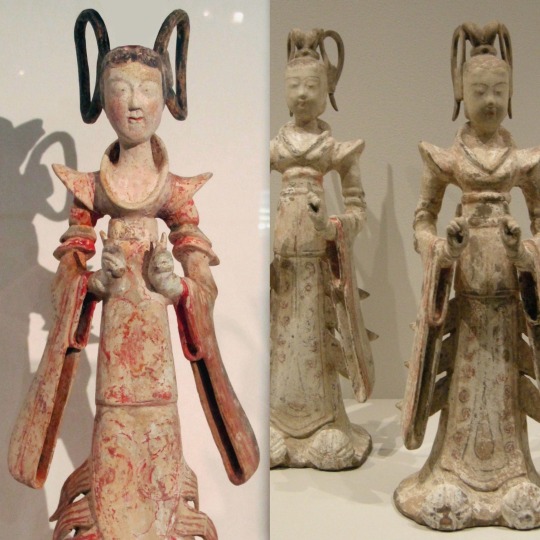


I think Qu Xiaofeng’s wedding dress in Goodbye My Princess was inspired to some extent by the “court ladies” statues from the Tang dynasty (618–907).
#china#chinese culture#east asia#chinese history#cdrama#chinese drama#hanfu#tang dynasty#wedding Hanfu#chinese wedding#dynastic China#goodbye my princess
343 notes
·
View notes
Text


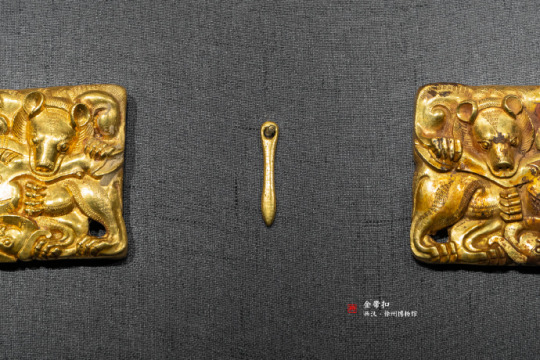



Everybody Eats Someone: Western Han Biting Artifact
Gold belt buckle of Western Han dynasty. Unearthed from the tomb of King of Chu of on Lion Rock (獅子山), Xuzhou (徐州), Jiangsu.
This dramatic buckle consists of two rectangular gold belt plates and a gold tongue. On the reliefs, everybody is eating someone. The heraldic bears of the Xiong (熊) clan, a prolongation of the royal House of Mi (芈), are present. The Ye (葉) family Taoist lineage I’ve examined here is from the same clan and House.
The bear totem is still pertinent for those with surnames Mi (芈), Yan (酓 or 檿), Shen (沈), Xiong (熊), Ye (葉), Xiang (項), Qu (屈).
The heraldic elements in the form of images represent rather archaic practice. They were gradually supplanted in China by the designation of belonging through the surnames’ hieroglyphs of or mottos.
On display in the Xuzhou Museum (徐州博物館).
#ancient china#chinese culture#chinese art#western han dynasty#han dynasty#antique jewelry#chinese jewelry#jewelry#jewelry design#ancient jewelry#gold#jewels#belt buckle#bear#chinese miniatures#House of Mi#State of Chu
183 notes
·
View notes
Note
Could you mention the spirit foxes you know please? The best known is Su Daji, and I know the story of Jade Fox (she's so cool. She fought Erlang), but I've wanted to know more. I also knows about the fox spirits from Strange tales from a Chinese studio.
JTTW fox spirits die so fast sadly.
JTTW foxes are like the Red Shirts of demons
The earliest "maybe" fox spirit is Yu the Great's wife, the Girl of Tushan. Basically, when he arrived at Tushan, he saw a nine-tailed fox, heard the locals singing about it, and decided to marry a girl there.
There are two readings of the text: 1) the fox is just an auspicious sign from Heaven, telling Yu to get married, and 2) the fox is an avatar, or transformation of the Girl of Tushan. Later Qing legends certainly favor the second reading, with foxes referring to themselves as the descendents of Tushan.
The other "maybe" fox spirit is Chunhu("Pure Fox"), Houyi's wife. Now, I heard you asking: "But wait! Isn't Houyi's wife Chang'e?" Well...there are actually two "Yi" in Chinese mythos-history.
The "Yi" people are most familiar with, who shot down the Sun Crows, supposedly lived in the time of Sage King Yao, while the "Yi" married to Chunhu was from the Xia dynasty.
(Rough timeline: Yao —> Shun —> Yu the Great —> his son Qi, founder of the Xia dynasty)
Basically, Houyi usurped Qi's son, Tai Kang, and seized his throne, then Han Zhuo usurped and killed him while he was out hunting.
According to 左传 + Qu Yuan's 天问 and 离骚, Chunhu played a vital part in this: a dark-skinned beauty, she was originally Hebo's wife, until Houyi killed her husband with an arrow and forcefully seized her, then she plotted with Han Zhuo to murder Houyi and became his wife.
Since Chunhu could also be written as Xuanhu("Dark Fox"), some scholars suggested that her clan might have used a black fox as their totem or worshipped such a divine beast. Unlike the Girl of Tushan, the implication of her being an actual fox wasn't as strong, but she did fit into that "plotting temptress" stereotype that would later be connected to fox spirits.
There is this one strange trivia in the Northern-Southern dynasty 搜神记 that goes: "All foxes come from this one slutty woman in ancient times called Ah Zi(阿紫), who turned into a fox, therefore fox spirits often refer to themselves with that name too."
The Ming dynasty novel, 三遂平妖传, is all about this family of foxes and how they were behind Wang Ze's failed rebellion in the Song dynasty: "Sagely Old Lady", her daughter Hu Mei'er/Yong'er, and her son Hu Chu'er/Zuo Chu.
When they passed Wu Zetian's tomb, her ghost appeared in Sagely Old Lady's dream, telling her that she would soon reincarnate into a male body, and that Mei'er is actually the reincarnation of her paramour, Zhang Liulang, and they promised to be husband and wife in every life.
When she woke up, Mei'er was missing, so she just went on and cultivated 72 Daoist arts using the Heavenly Scroll this Egg Monk guy stole from a cave. Meanwhile, Mei'er landed in an enunch's garden, was adopted as his daughter, tried to charm the Crown Prince by disguising herself as a consort and got insta-killed by Guan Yu the guardian deity.
She reincarnated again as Yong'er, and reunited with Sagely Old Lady and her brother, who taught her Daoist arts and began to plot a rebellion. They managed to convince Wang Ze, a minor official, into leading it——who just happened to be Wu Zetian's reincarnation, so naturally Yong'er married him.
Alas, their rebellion was not to be: Egg Monk, disgusted by their behaviors, left to seek help from the Mystic Lady of the Nine Heavens, and, with the arts she taught, crushed the rebels.
Yong'er and Zuo Chu got struck dead by divine thunderbolts, while Sagely Old Lady was spared thanks to her fellow heavenly foxes' pleadings, but sentenced to guard the Heavenly Scroll forever.
This wouldn't be the first time Wu Zetian was associated with foxes: in the Qing dynasty novel, Flowers in the Mirror(镜花缘), she straight up is the Heart Moon Fox(心月狐) incarnate, one of the 28 Lunar Mansions.
She reincarnated because the two Sui emperors kept complaining in the Underworld about how they were usurped by the Tang, until the Celestial Court went "Okay, fine, we'll send one of our own to usurp the Tang dynasty too. Happy?"
Which, like Daji, is very much in line with the "A powerful woman? *gasp* She must be a fox demoness!" literary tradition.
67 notes
·
View notes
Text


Yao Luan 姚鑾
Ghosts, 19th century, Quing Dynasty
111 notes
·
View notes
Text
Ripe Town (繁城之下) | Cdrama | Whump List
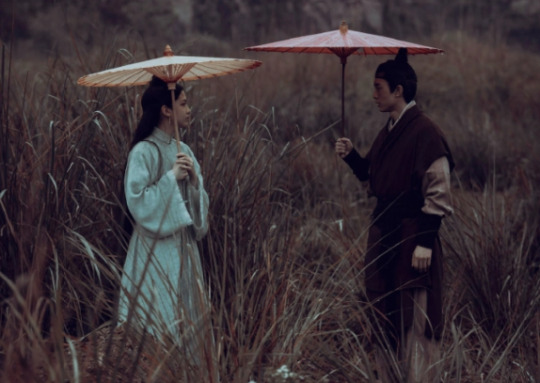
Genre: Historical, Mystery, Thriller
Synopsis: In the 37th year of the Wan Li Period of the Ming Dynasty, there were successive murders in the county seat of Jiangnan County. The unrelated corpses were arranged in bizarre poses, and there was a sentence left at the scene of each case. As the apprentice of the first victim, Xiaohu Kuaiqu Sanren cooperated with his friends to launch an investigation. With the deepening of the investigation, the three religions and nine streams, local farmers, workers, and merchants of all colors appeared one after another. Amidst the fog, an old case from ten years ago surfaced. Who would the murderer be, and for what purpose?
Length: 12 eps
Whump meter: ▲▲▲◭△
✨Truly a one-of-a-kind sort of drama. Felt so real and every single actor NAILED their role. Plenty whump too ✨
⚠️Trigger Content: Child abuse, usual historical cdrama CWs
⚠️⚠️Some SPOILERS will be found, proceed with caution ⚠️⚠️

Whumpee: Qu Sangeng played by Bai Yu Fan (白宇帆)
Ep 1 | [02:00] In shock upon finding his mentor's corpse, falls to the ground, screams | Tearing up | [10:05] (in past) Pulled out of a fight (arm dislocated but not revealed until later), thrown to the ground, bruised eye, concern for him | [12:15] (in past) wound treated by mentor, lying on the table, arm massaged, arm slowly relocated, groans, in pain.
Ep 2 | Drunk, pulled away from a fight, restrained | [28:30] Sees his deceased mentor in the room with him, crying | [32:27] Getting drunk by himself, trips and falls to the ground, struggling to get up, struggling to walk, groans, water thrown on him to sober him up.
Ep 3 | None.
Ep 4 | No appearance.
Ep 5 | [03:45] Lying on a bench awaiting punishment, sweating, flogged repeatedly, gasping softly, flogged again, in pain, struggling to talk, berated, panting | [21:10] Hit in the face with cloth full of powder, stumbles back, coughing, leans against a wall for support, beaten with a pole, restrained by either arm and beaten repeatedly, crying out in pain, saved, falls to his knees, leaning against the wall, clutches leg, struggling to get up | [44:10] Walking with a crutch for the rest of the episode.
Ep 6 | [10:15] Struggling to walk, holding onto the wall for support, clutching leg, limping, arrested | [12:38] Tied up with rope, kneeling in front of superior, wrongly accused | [17:35] Made to count the punishment of his peers, berated, made to punish his friend, restrained | [26:10] Manhandled onto the bench and made to lie down, repeatedly flogged, struggling to talk | Imprisoned (off screen), in a cell.
Ep 7-9 | None.
Ep 10 | No appearance.
Ep 11 | Fought.
Ep 12 | [57:26] Restrained by either arm, held down | Tied up, beaten with a cane, made to look up with the tip of the cane | [ 01:05:45] Sees ally dead, struggling to hold back tears, trembling, shaky voice, crying, leans against table, voice cracks, struggling to walk as he cries, blames self for the death of his ally and peers, trips and catches himself on the side of table, sobbing | Teary eyed, comforted by friend.
46 notes
·
View notes
Text
@diegoedil replied to your post “House Words Wednesdays: House Mudd”
But is Mudd House really extinct? In episode 4 of season 1 of HOTD, one of Rhaenyra's suitors apparently belongs to that House, as you can see his sigil on his chest.
I'm reposting this as a reminder to everyone that I am not talking about That Other Show and will be blocking anyone using my posts to talk about That Other Show.
As far as the books are concerned, House Mudd went extinct millennia ago. See, for example, this conversation between Catelyn and Robb in ASOS:
Robb studied the sepulcher. "Whose grave is this?"
"Here lies Tristifer, the Fourth of His Name, King of the Rivers and the Hills." Her father had told her his story once. "He ruled from the Trident to the Neck, thousands of years before Jenny and her prince, in the days when the kingdoms of the First Men were falling one after the other before the onslaught of the Andals. The Hammer of Justice, they called him. He fought a hundred battles and won nine-and-ninety, or so the singers say, and when he raised this castle it was the strongest in Westeros." She put a hand on her son's shoulder. "He died in his hundredth battle, when seven Andal kings joined forces against him. The fifth Tristifer was not his equal, and soon the kingdom was lost, and then the castle, and last of all the line. With Tristifer the Fifth died House Mudd, that had ruled the riverlands for a thousand years before the Andals came."
As well as this academic discussion from Yandel in TWOIAF:
The penultimate and greatest of the river kings to stand before the Andals was Tristifer IV of House Mudd, the Hammer of Justice, who ruled from a great castle called Oldstones, on a hill by the banks of the Blue Fork. The singers tell us he fought a hundred battles against the invaders and won nine-and-ninety of them, only to fall in the hundredth, when he rode to war against an alliance of seven Andal kings. Yet it seems convenient that there are seven kings in the songs; likely this is another tale concocted by the septons as a lesson in piety.
Before the Mudds, there had been other kings near as powerful. The Fishers are said in some chronicles to have been the first and oldest line of river kings (in others, they are accounted the second dynasty, and the fragmentary Annals of the Rivers from the ancient septry at Peasedale suggests they were third). The Blackwoods and Brackens both claim to have ruled the riverlands at various times during the Age of Heroes. The Mudds succeeded in unifying more of the riverlands than any of their predecessors, but their reign was not to last. The Hammer of Justice was succeeded by his son, Tristifer V, or Tristifer the Last, who proved unable to stem the Andal tide and failed even to hold his own people together.
To be sure, there was at least one other would-be claimant to the Mudd legacy in Westerosi history: Marq Mudd, the so-called "Mad Bard", one of those "dozen pretenders from as many houses would adopt the style of River King or King of the Trident and vow to throw off the yoke of the stormlanders". However, both his reappearance millennia after the fall of House Mudd as a royal dynasty as well as his "mad" epithet suggests to me that this Marq was less a late-appearing heir to a long-gone royal dynasty and more an ambitious adventurer canny enough to play on the mystique of a storied old name but uncertain enough not to be widely accepted as such. Indeed, Jon Connington himself links use of the "Mudd" name, among others, within the Golden Company with vaulting, specifically unearned dynastic pride:
Some of the sellsword captains bore bastard names, as Flowers did: Rivers, Hill, Stone. Others claimed names that had once loomed large in the histories of the Seven Kingdoms; Griff counted two Strongs, three Peakes, a Mudd, a Mandrake, a Lothston, a pair of Coles. Not all were genuine, he knew. In the free companies, a man could call himself whatever he chose.
See also this comment from GRRM:
A question that crops up concerning the two old River King dynasties -- is it wrong to assume that one of them was the line of the final River Kings, ended by the ancestors of the Storm King Arrec, and that the other (as Theon recollects in his first chapter in Clash of Kings) is the line ended by the old King of the Iron Islands whose slaughter of the then River Kings sons led to the naming of the Bloody Keep?
A logical assumption, and maybe half true. There were actually more dynasties in the riverlands than these two ... [sic] but so far I've only come up with two names. The riverlands have been much warred over. The Mudds were the last of the First Men to rule the Trident, I seem to recall; it was Andal invaders who put an end to that line.
23 notes
·
View notes
Text
peony

Well, November is upon us and the year is drawing to a close. Or another beginning depending on how you look at it. In the Northern Hemisphere the leaves are busy changing colors, the birds are halfway to their winter homes, the last butterfly cocoon is tucked in and hidden for the coming cold and November children are busy trying to fend off Christmas decorations long enough to celebrate their birthdays.
Let's talk about flowers to help with that.
November has two official flowers. The chrysanthemum and the peony. Happenstance I re-imagined a peony ghost story for Halloween so we're going to talk about that flower for this post.
The peony can either be a tree blossom or a more tradition herbaceous flower. Native to Asia, Europe and North America, most of the time when we think of peony flowers, we're thinking of the ones that were cultivated and rose to fame in China. From 618 to 907, the Tang dynasty was in power in China and while the previous Sui dynasty had seen a growing fascination with the peony, it was the Tang dynasty that solidified it as a symbol of China, filling the imperial gardens with them. The Song dynasty that followed saw the city of Luoyang becoming both the capitol of the dynasty and of peony cultivation, a distinction that the city still, peony at least, holds to this day. The Quing dynasty saw the city of He Ze, or Cáozhōu, becoming a second center for peony flowers. Cáozhōu is also still a center for peony exhibitions and state-funded research. The peony was the official flower of China until 1929. To this day it is still known as 'the King of the Flowers'.
The peony's fame didn't stay in China however. Japan saw the introduction of the flower sometime before the tenth century and fell in love with it as well, working the peony into their stories and folklore. In the nineteenth century, Europe went wild for the flower, especially in France and the United Kingdom where cultivators began experimenting with various strains, and the Netherlands became the largest exporter, a distinction they hold to this day with over 50 million stems sold each year. In a fun twist, Alaska is starting to show up as an exporter as well, with its long sunny days during the summer turning out to be prime for the flowers' growth.
The peony isn't just a pretty face either. Before it was celebrated for its beauty it was known as a medicinal plant. In China and Japan, the peony root was used to treat convulsions. To this day, people still use its petals in teas and salads. In England, children wore necklaces made of the root to help with teething and prevent seizures. The peony even, very early on, spread as far as regions of the Mediterranean were we got the standard english version of its name from Greek myths. In one, Apollo, to no one's surprise, is pursuing a nymph named Paeonia, who grew embarrassed when she realized Aphrodite was being a voyeur about it and, for that sin, Aphrodite turned her into a flower. In the other myth, there's a physician named Paeon, who used the root of the peony flower to cure Pluto. Paeon's mentor, the god of medicine Aesculapius, grew jealous of this feat and attempted to kill his student. Again a god fell back on the flower solution and Pluto (or Zeus in some versions) turned Paeon into a peony flower so everyone would praise him for being beautiful. Because - priorities.
As for superstitions about the peony - its considered dangerous to pick its seeds while a woodpecker is about. If it sees you, it will peck out your eyes! A peony bush full of flowers is good luck but once they start to wilt and fall off you should prepare for bad luck (given its natural for flowers to do this, gardeners apparently need to get picking). It's also bad luck to give or receive an odd number of peony flowers in a bouquet or to have an odd number bloom on your bush. Fairies are rumored to hide in a peony flower's petals. Thanks to Utagawa Kuniyoshi, a Japanese master ukiyo-e artist from the 1800s, who drew warriors with peony tattoos, the flower can symbolize, especially in tattoos, a masculine devil-may-care and 'damn the consequences' attitude. The red peony in Serbia is said to spring from the blood of the Serbian warriors who died in the Battle of Kosovo in 1389. It is the state flower of Indiana in the United States.
In the language of flowers, the peony can represent shame or bashfulness. The flower also symbolizes romance, wealth, honor, bravery, compassion and a happy relationship or happy marriage. It is also the flower given on the twelfth wedding anniversary.

#peony#birth flower#november#cottagecore#folklore#superstition#herbalism#birth month flower#encouragement#birth month#november flower#china#greek mythology#alaska#indiana
27 notes
·
View notes
Text
Super catty and passive-aggressive academic drama/critical reviews unironically teaching me a massive amount about Quing Dynasty administration
26 notes
·
View notes
Text
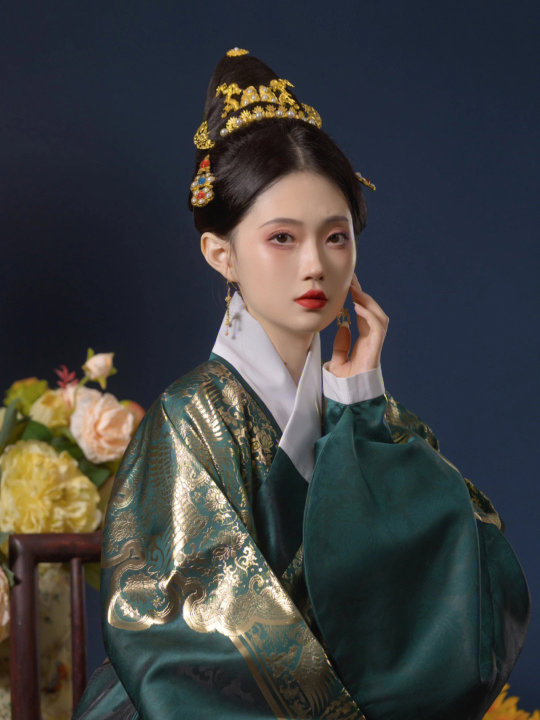

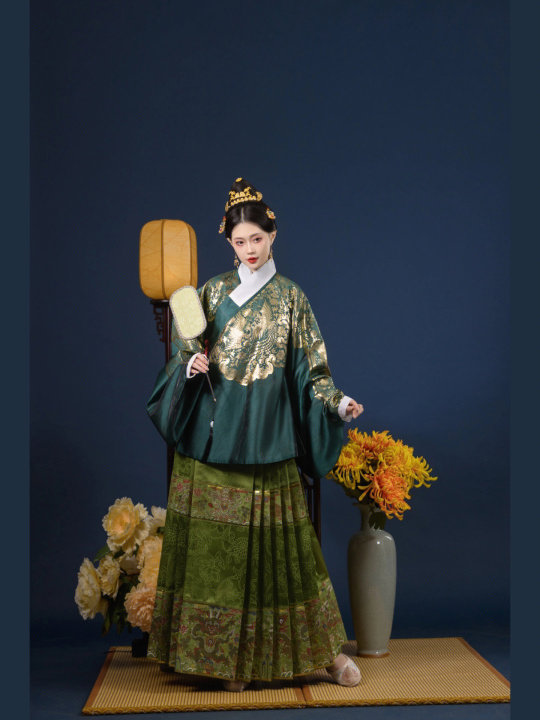

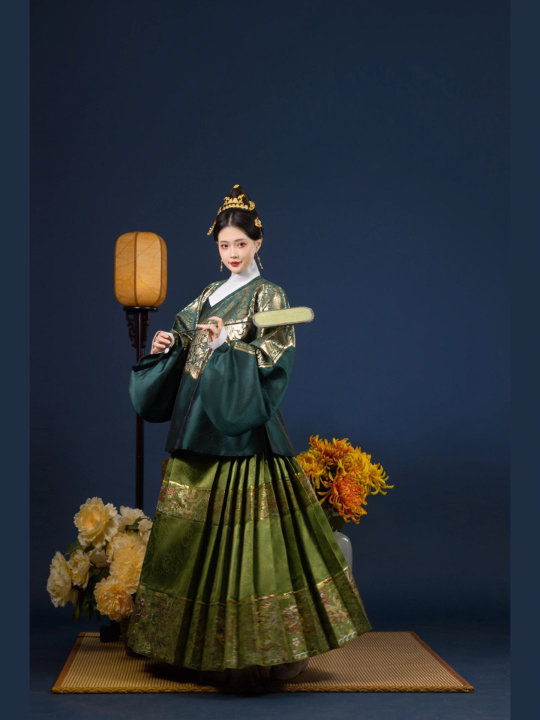
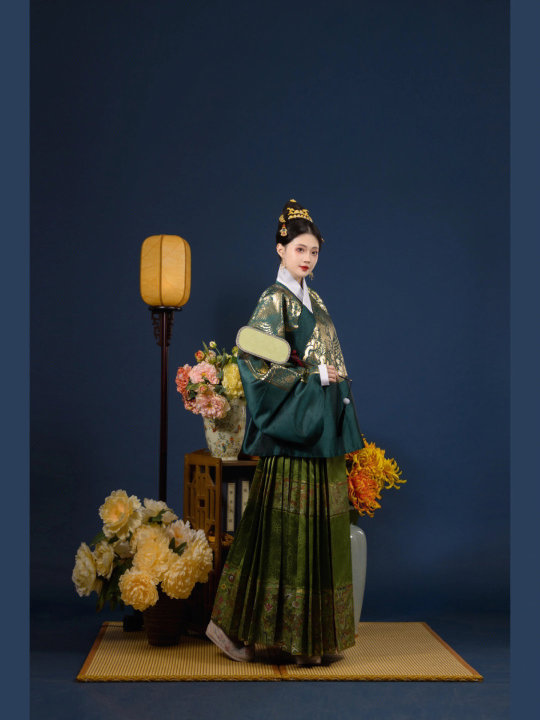
Gorgeous Ming Dynasty Hanfu
via Hanfu Photographer San Qian Qu (三千渠)
164 notes
·
View notes
Text
Wordplay in Xie Wanqing's fate poem
One of the things that confused me most in Love Between Fairy and Devil is why our protagonists insist that Xiao Run has to be the destined lover and murderer of Xie Wanqing, when the English subtitles only say she has to die at the hands of her "beloved," which could be Dongfang Qingcang, right??? Easy! Why do they lose all hope when Xiao Run doesn't follow their plans?
The TL;DR is that there's a bit of ambiguity in Xie Wanqing's fate poem, and xiao-Lanhua and co. interpreted it a little too literally, while the Netflix subs gave us the more abstract meaning.
Here is the crucial line, according to Netflix subs:
Then she meets her beloved who understands her well
In Chinese, it is
偏逢萧郎解语人
pian feng xiao lang jieyu ren
In particular, the two characters 萧郎 or Xiao-lang, superficially mean "a man whose surname is Xiao," the same Xiao character as in Xiao Run. This line could conceivably mean, "Then she meets Mr. Xiao, who understands her well," which is how xiao-Lanhua and friends interpreted it.
However, if you search for Xie Wanqing's fate poem on the web, you'll find lots of posts in Chinese explaining that 萧郎/Xiao-lang is actually a poetic way to indicate a woman's beloved. It has origins in multiple historical figures surnamed Xiao, but the definitive usage is in a poem by Tang-dynasty poet Cui Jiao, in which he laments that his lover, a maid, was purchased by another man, and alludes to himself as Xiao-lang [See https://www.gushiwen.cn/mingju_576.aspx]. Hence "Xiao-lang" became a way to refer to the person a woman loves. And as we see later in the show, the Netflix subs are actually right in interpreting "Xiao-lang" as "beloved," and not an actual person named Xiao.
To draw an English parallel, I think it's a bit as if the poem had mentioned a person named Romeo, and there just happened to be a guy named Romeo in the vicinity. I, as a viewer with a modicum of English literary education, know that "Romeo" can be a general epithet for a loverboy, but a thousands-years-old immortal with no connections to the human world might not.
That's not the end of the wordplay in the fate poem, though it is the most important. Here are some small things I found on the rest of the lines:
半世锦绣半世尘
ban shi jinxiu ban shi chen
Mine: Half a lifetime of splendor, half of dust
Netflix: Half a lifetime of glory, half a lifetime of dust
Notes: The word 风尘, meaning prostitution, literally breaks down into "wind-dust," and the 尘 (dust) in the poem probably alludes to this, according to https://www.douban.com/group/topic/273507772/?_i=8820568QDrpMtA.
一舞惊鸿倾鹿城
yi wu jinghong qing lucheng
Mine: The elegance of a beautiful dance overwhelms Lucheng
Netflix: A magnificent dance stunned the whole Lucheng
韶华等闲随烟柳
shaohua dengxian sui yanliu
Mine: A beautiful spring thoughtlessly follows the budding willows
Netflix: Her beauty is just like the willow's
Notes: https://www.douban.com/group/topic/273507772/?_i=8817957xu4lIgj suggests that this means Xie Wanqing is unhappy with her life and fate despite her status as Lucheng's number-one courtesan. https://edu.iask.sina.com.cn/bdjx/6fnw1wJF5xw.html explains that 烟柳 yanliu refers to the time when willow trees are covered in tender budding leaves that are not yet green, giving them the appearance of being shrouded in smoke.
凭栏元夜闻笛声
pinglan yuanye wen di sheng
Mine: Leaning on the railing, she hears a flute on the night of the Lantern Festival
Netflix: She hears the flute on the night of the Lantern Festival
断肠几欲飞仙去
duanchang jiyu fei xian qu
Mine: Grief-stricken, she almost flies to the heavens
Netflix: She is heartbroken and wants to end her life
Notes: 仙去 is a poetic or figurative way to say someone dies, but also literally means "goes to the fairy realm," a nod to Xie Wanqing's real identity as the fairy God of War.
偏逢萧郎解语人
pian feng xiao lang jieyu ren
Mine: Unexpectedly, she meets a man surnamed Xiao who understands her
Netflix: Then she meets her beloved who understands her well
Notes: Discussed above.
缘定花朝丝萝梦
yuan ding huazhao siluo meng
Mine: Fate ordains a dream of marriage on the second month's fifteenth day
Netflix: They are destined to be together
红烛剑影断芳魂
hong zhu jian ying duan fanghun
Mine: The shadow of the sword in the light of the celebratory red candle cuts the young woman's soul short.
Netflix: Her husband kills her on the wedding night
Notes: https://www.douban.com/group/topic/273293366/?_i=8819367xu4lIgj agrees with me that this does not necessarily mean the groom will be the killer.
#love between fairy and devil#cang lan jue#苍兰诀#circ talks#canglanjue#boy do I feel for those translators#can you imagine having to decide how to subtitle that#do we go with the superficial meaning so viewers can follow xlh and co's reasoning#or do we go with the correct meaning and let viewers assume our protags are kinda dumb#do we give a whole literature lesson to make it clear#or do we maintain the little bit of suspense and mystery
73 notes
·
View notes
Text
"The numerous gods of the Mount Jiuyi have arrived, they arrive as plentiful as the clouds as they greet Lady Xiang. " "SHL Episode 9 - Qu Yuan's Cu Ci Nine Song九歌 Series Lady Xiang 湘夫人"
I deliberated for a long time as to whether I’d translate this poem. But this likely where Gu Xiang got her name from so I just had to do it. I thought this would be a simple poem but it took me more than a month to do it lol. XD
When native cn speakers come across a lady with the name Xiang 湘, it immediately brings to mind the two Xiang River Goddesses. They were said to be the concubine of the legendary Emperor Shun. “Lady Xiang 湘夫人” is a Pre Qin poem that’s written as part of Qu Yuan's Chu Ci Jiu Ge/Nine Song series, and it’s also known as the sister poem to “Xiang Jun 湘君”.
There are many interpretations as to who the focus of the story is. But for the sake of this translation, I’ll be working on the assumption that the poem is about Lady Xiang missing her husband (Emperor Shun). The poem’s really long and only the last part’s quoted in SHL, so feel free to skip to the end of the translation.
This poem's known its vibrant descriptions and there's a bunch of reference to specific plants which I've linked. If you ever intend to write a fic in the Chu dynasty, or a fic centered around the 700-200BC, you could use this as a visual reference. (yas my nerdy friends, historical accuracy is sexy)
帝子降兮北渚,目眇眇兮愁予。
Lady Xiang has arrived at the Northern Island, my gaze is filled with sadness and worry.
北渚: This was likely referring to 君山岛 Junshan Island. There's a lot of historical sites if you ever want to go there!

袅袅兮秋风,洞庭波兮木叶下。
The autumn wind blows gently endlessly; the Dongting lake ripples, the leaves fall.
登白薠兮骋望,与佳期兮夕张。
Standing amidst the reeds as I gaze into the distance, anticipating the date with the lover tonight.

鸟何萃兮蘋中,罾何为兮木上?
Why do the birds gather amongst the reeds? Why are the fishnets on the tops of the trees?
This line implies that the birds should be in the trees, and the fishnets among the aquatic reeds. But yet the situation’s the reverse. (Ie. what should have happened has t happened.). It describes the author’s uneasy feelings.
T/N: Just in case anyone’s as nerdy as me, this is likely a mirror of the line “采薜荔兮水中,搴芙蓉兮木末 I want to pick the scallops in the water, and to pluck the lotus from the trees” in sister poem in the same series, 湘君 Xiang Jun.
And look, more pictures of plants! (yes it's a different reed xD)

沅有芷兮澧有兰,思公子兮未敢言。
Th flower from the ginseng plant in the River Yuan, and orchids in the Lishui River. I can’t describe how much I miss you, Young Master (Gongzi).
T/N: Interestingly, 公子 Gongzi (aka Young Master) could be used on both male and female in the past. This is a very interesting point because there’s actually a huge debate as to who’s the poem is referring to. Baidu has interpreted this to mean Miss Xiang (ie. the goddess), but on the contrary, one physical book (yes I take this seriously lmao) I’ve bought thinks this is referring to Xiang Jun (the subject in her sister poem, and possibly her husband), and another physical book refrains from nailing the subject down. So who knows LOL.
And just how gorgeous is the ginseng flower!

荒忽兮远望,观流水兮潺湲。
My emotions are unsettled, I gaze towards the distance with uncertainty. However, the River Yuan and Lishui flows slowly.
麋何食兮庭中?蛟何为兮水裔?
Why does the deer seek food in the courtyard? Why do the dragon (jiaolong) trapped on the river bank?
T/N: 麋: This term actually refers to the deer, but it has been described as “antlers like a deer, tail of a donkey, hooves of a cow, face of a horse” in ancient times, so it’s sometimes regarded as the mythological creature 四不像 (Si Buxiang/Four not alike). It has made an appearance in some anime, and in one particular danmei fandom’s discourse. LOL
The mythological version is supposed to look like this. XD

蛟: Jialong refers to the “scaled dragon” in chinese mythology. If you’ve been watching Till the End of the Moon, Mingye was a jialong whom cultivated and became an immortal.

朝驰余马兮江皋,夕济兮西澨。
When morning comes, I ride my horse and race down the river bank. I cross over to the western bank at night.
闻佳人兮召予,将腾驾兮偕逝。
I hear my lover summons me. So I speed towards hastily and we head off together.
筑室兮水中,葺之兮荷盖。
We build our house in the water, and cover our roof with lotus leaves.
荪壁兮紫坛,播芳椒兮成堂。
The walls are decorated with moss, and purple shells pave the floor. The fragrant pepper and dirt we mould form the family’s prayer hall.
T/N: 芳椒 - This was a specific type of fragrant pepper. This was mixed with mud and painted on the walls, as the ancient people enjoyed its aroma. The moss refers to this specifically!
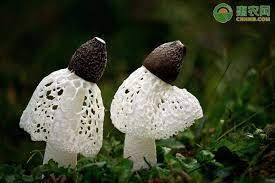
桂栋兮兰橑,辛夷楣兮药房。
The wood of the Gui tree form the beams, the Magnolia forms the rafters. The crossbeams of the door are made from wood of the Xinyi tree, the white ginseng flowers decorates the medicinal room.
T/N: 辛夷 - The Xinyi tree is also part of the magnolia family. There's clearly a theme going on!
The Gui tree's so pretty! And the white magnolias!
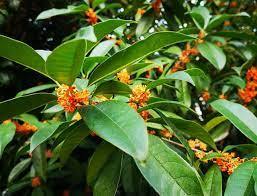
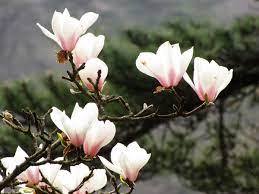
And the Xinyi tree

罔薜荔兮为帷,擗蕙櫋兮既张。
The climbing fig is woven into a curtains, and the partitions made of flowers have been drawn.
T/N: 薜荔: Baidu says it’s the climbing fig, but my physical book thinks it’s the another magnolia plant. And the 蕙 flower was known for its fragrance.
Baidu's interpretation!

And my book's interpretation XD

And look, the pretty 蕙 flower!

白玉兮为镇,疏石兰兮为芳。
The weights are made of snowy white jade, the fragrance of orchards permeates the air.
T/N: The 镇 Weights were similar to paper weights, and were used to keep mats/clothes in their place. It originated from the Qin and Han Dynasty, whereby people used to keep the mat in place (to prevent it from moving around when they got up). Sometimes, it'll be in the shape of an animal, like a lion for example.

芳: Another interesting point; Baidu interprets this as fragrance, but the physical book thinks it means to block off the wind from the head of the bed. 芳 is sometimes interpreted as 防 (to block in some ancient text)
芷葺兮荷屋,缭之兮杜衡。
The lotus form the house, and the ginseng flowers form the roof. It’s scent intermingles with that of the wild ginger
And this is how wild ginger looks like!

合百草兮实庭,建芳馨兮庑门。
We gather various kinds of flowers and plants to fill the courtyard, and we’ve build a fragrant porch.
九嶷缤兮并迎,灵之来兮如云。 (The line that's in SHL)
The numerous gods of the Mount Jiuyi have arrived, they arrive as plentiful as the clouds as they greet Lady Xiang.
T/N: 九嶷: Jiuyi mountain was the legendary burial place of the legendary Emperor Shun. It’s a mountain range in Hunan Province, located at the south of the river Xiang 湘水南.

捐余袂兮江中,遗余褋兮澧浦。
I throw my outer garment into the river. And I throw my inner undergarment into the Lishui.
搴汀洲兮杜若,将以遗兮远者。
Arriving at the island’s river bank, I pluck the flowers as I eagerly await for my lover.

时不可兮骤得,聊逍遥兮容与。
Good times won’t return once it has passed. I’ll travel leisurely as I wander freely.
48 notes
·
View notes